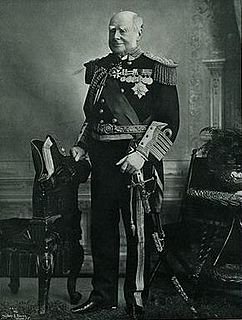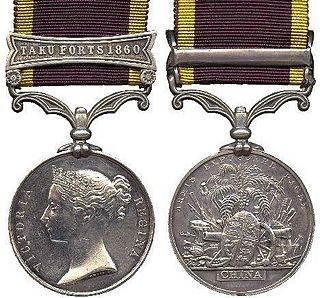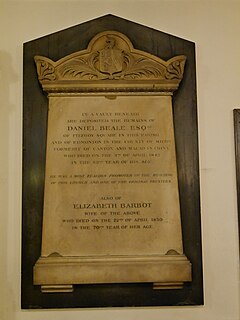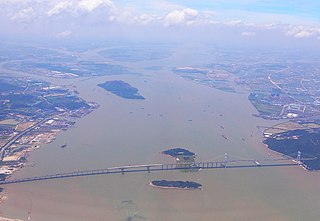
The First Opium War, also known as the Opium War or the Anglo-Chinese War, was a series of military engagements fought between the United Kingdom and the Qing dynasty of China over diplomatic relations, trade, and the administration of justice in China.

Admiral of the Fleet Sir Edward Hobart Seymour, was a Royal Navy officer. As a junior officer he served in the Black Sea during the Crimean War. He then took part in the sinking of the war-junks, the Battle of Canton and the Battle of Taku Forts during the Second Opium War and then saw action again at the Battle of Cixi during the Taiping Rebellion.

The Convention of Chuenpi was a tentative agreement between British Plenipotentiary Charles Elliot and Chinese Imperial Commissioner Qishan during the First Opium War between the United Kingdom and the Qing dynasty of China. The terms were published on 20 January 1841, but both governments rejected them and dismissed Elliot and Qishan, respectively, from their positions. Foreign Secretary Lord Palmerston stated that Elliot acquired too little while the Daoguang Emperor believed Qishan conceded too much. Palmerston appointed Major-General Henry Pottinger to replace Elliot, while the emperor appointed Yang Fang to replace Qishan, along with Yishan as General-in-Chief of Repressing Rebellion and Longwen as an assistant regional commander. Although the convention was unratified, many of the terms were later included in the Treaty of Nanking (1842).

Admiral of the Fleet Sir Henry Keppel was a Royal Navy officer. His first command was largely spent off the coast of Spain, which was then in the midst of the First Carlist War. As commanding officer of the corvette HMS Dido on the East Indies and China Station he was deployed in operations during the First Opium War and in operations against Borneo pirates. He later served as commander of the naval brigade besieging Sebastopol during the Crimean War. After becoming second-in-command of the East Indies and China Station, he commanded the British squadron in the action with Chinese pirates at the Battle of Fatshan Creek when he sank around 100 enemy war-junks. He subsequently took part in the capture of Canton during the Second Opium War.

Ersha Island or Jisa Island, formerly Napier Island in English, is an island in the Yuexiu District of Guangzhou, Guangdong Province, China. It houses the American International School of Guangzhou elementary school campus, several apartment complexes, a badminton stadium, and a government sports training facility. Er Sha Island is also home to the Guangdong Museum of Art and the Xinghai Concert Hall. It also contains several small parks: Chianqi, Hong Cheng, Ershadao Sports park, and Guangzhou Fazhan park.

The Battle of the Barrier Forts was fought between American and Chinese forces in the Pearl River, Guangdong, China in November 1856 during the Second Opium War. The United States Navy launched an amphibious assault against a series of four forts known as the Barrier Forts near the city of Canton. It was considered an important battle by the British whose interest lay in capturing Canton.

The Battle of the Bogue was fought between British and Chinese forces in the Pearl River Delta, Guangdong province, China, on 23–26 February 1841 during the First Opium War. The British launched an amphibious attack at the Humen strait (Bogue), capturing the forts on the islands of Anunghoy and North Wangtong. This allowed the fleet to proceed further up the Pearl River towards the city of Canton (Guangzhou), which they captured the following month.

The Second China War Medal was issued by the British Government in 1861 to members of the British and Indian armies and Royal Navy who took part in the Second Opium War of 1857 to 1860 against China. The medal was designed by William Wyon.

Vice-Admiral Sir Thomas Herbert, KCB, was British Royal Navy officer. He served in the Napoleonic Wars, War of 1812, and First Anglo-Chinese War. From 1847 to 1849, he was commodore of the South East Coast of America Station. Herbert served as Member of Parliament for Dartmouth as a Conservative from 1852 to 1857.

Captain Sir Humphrey Fleming Senhouse, KCH, CB was a British Royal Navy officer. He served in the Napoleonic Wars, War of 1812, and First Anglo-Chinese War. In China, he was the senior naval officer of the British fleet from 31 March 1841 until his death on board his flagship, HMS Blenheim, in Hong Kong from fever contracted during the capture of Canton.

The Broadway expedition was a British military expedition that explored the Broadway River in Guangdong province, China, on 13–15 March 1841 during the First Opium War. The river was also called the Inner Passage or Macao Passage as it served as an intricate channel from the Portuguese colony of Macao to the Chinese city of Canton (Guangzhou). The expedition was the first time a European vessel traversed the passage, and was believed by the Chinese to be inaccessible to foreigners due to the shallowness and intricacy of the channel as well as the forts along the banks. The iron steamship Nemesis had a shallow draught of 6 feet (1.8 m), which was a major advantage in navigating the river. Despite being over 600 tons burden, the ship was able to navigate through a river that frequently had less than 6 feet of water and through mud in areas of only 5 feet (1.5 m).

The Battle of the Bogue was fought between British and Chinese forces at the Humen strait (Bogue), Guangdong province, China, on 12–13 November 1856 during the Second Opium War. The British captured the forts in the Wangtong Islands on 12 November and the forts in Anunghoy Island the next day.

Daniel Beale (1759–1842) was a Scottish merchant and fur trader active in the Far East mercantile centres of Bombay, Canton and Macau as well as at one time the Prussian consul in China.

Robert Thom was an English nineteenth century Chinese language translator and diplomat based in Canton who worked for the trading house Jardine, Matheson & Co. and was seconded to the British armed forces during the First Opium War (1839 – 1842).

The Battle of Canton was fought between British and Chinese forces at the city of Canton (Guangzhou), Guangdong province, China on 23 October to 5 November 1856 during the Second Opium War.

The Capture of the French Folly Fort by British forces in China occurred on 6 November 1856 during the Second Opium War. The British dispersed 23 Chinese war junks and captured the French Folly fort in the Pearl River near the city of Canton (Guangzhou) in Guangdong province. The battle lasted nearly an hour. The British consul Harry Parkes described the Chinese as putting up "a very hot resistance" and the engagement as "exceeding creditable to the bravery not only of our men, but of the Chinese also."

Qianshan is a subdistrict of Xiangzhou District, Zhuhai, in Guangdong Province in the People's Republic of China. Formerly an important military base overseeing the Portuguese-administered enclave of Macao, it is now a Chinese manufacturing center, with particular emphasis on household appliances, airconditioners, and printing supplies.
Events from the year 1857 in China.

Helena was a China packet built by William H. Webb in 1841. Helena is often called a "pre-clipper" or "early clipper ship", type of the fast ships that were a precursor to the fast clippers that dominated the China trade routes for years to follow.

























